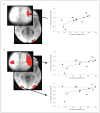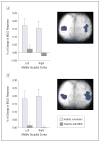Potential of pretreatment neural activity in the visual cortex during emotional processing to predict treatment response to scopolamine in major depressive disorder
- PMID: 23364679
- PMCID: PMC3717361
- DOI: 10.1001/2013.jamapsychiatry.60
Potential of pretreatment neural activity in the visual cortex during emotional processing to predict treatment response to scopolamine in major depressive disorder
Abstract
Context: The need for improved treatment options for patients with major depressive disorder (MDD) is critical. Faster-acting antidepressants and biomarkers that predict clinical response will facilitate treatment. Scopolamine produces rapid antidepressant effects and thus offers the opportunity to characterize potential biomarkers of treatment response within short periods.
Objective: To determine if baseline brain activity when processing emotional information can predict treatment response to scopolamine in MDD.
Design: A double-blind, placebo-controlled, crossover study together with repeated functional magnetic resonance imaging, acquired as participants performed face-identity and face-emotion working memory tasks.
Setting: National Institute of Mental Health Division of Intramural Research Programs.
Participants: Fifteen currently depressed outpatients meeting DSM-IV criteria for recurrent MDD and 21 healthy participants, between 18 and 55 years of age.
Main outcome measure: The magnitude of treatment response to scopolamine (percentage of change in the Montgomery-Asberg Depression Rating Scale score between study end and baseline) was correlated with blood oxygen level-dependent (BOLD) signal associated with each working memory component (encode, maintenance, and test) for both identity and emotion tasks. Treatment response also was correlated with change in BOLD response (scopolamine vs baseline). Baseline activity was compared between healthy and MDD groups.
Results: Baseline BOLD response in the bilateral middle occipital cortex, selectively during the stimulus-processing components of the emotion working memory task (no correlation during the identity task), correlated with treatment response magnitude. Change in BOLD response following scopolamine administration in overlapping areas in the middle occipital cortex while performing the same task conditions also correlated with clinical response. Healthy controls showed higher activity in the same visual regions than patients with MDD during baseline.
Conclusion: These results implicate cholinergic and visual processing dysfunction in the pathophysiology of MDD and suggest that neural response in the visual cortex, selectively to emotional stimuli, may provide a useful biomarker for identifying patients who will respond favorably to scopolamine.
Trial registration: clinicaltrials.gov Identifier: NCT00055575.
Conflict of interest statement
Figures







Similar articles
-
Pretreatment Differences in BOLD Response to Emotional Faces Correlate with Antidepressant Response to Scopolamine.Int J Neuropsychopharmacol. 2015 Mar 28;18(8):pyv028. doi: 10.1093/ijnp/pyv028. Int J Neuropsychopharmacol. 2015. PMID: 25820840 Free PMC article.
-
Amygdala response to explicit sad face stimuli at baseline predicts antidepressant treatment response to scopolamine in major depressive disorder.Psychiatry Res Neuroimaging. 2016 Aug 30;254:67-73. doi: 10.1016/j.pscychresns.2016.06.005. Epub 2016 Jun 20. Psychiatry Res Neuroimaging. 2016. PMID: 27366831 Free PMC article.
-
Antidepressant efficacy of the antimuscarinic drug scopolamine: a randomized, placebo-controlled clinical trial.Arch Gen Psychiatry. 2006 Oct;63(10):1121-9. doi: 10.1001/archpsyc.63.10.1121. Arch Gen Psychiatry. 2006. PMID: 17015814 Free PMC article. Clinical Trial.
-
[Interest of scopolamine as a treatment of major depressive disorder].Encephale. 2016 Dec;42(6):568-573. doi: 10.1016/j.encep.2016.06.002. Epub 2016 Sep 9. Encephale. 2016. PMID: 27623122 Review. French.
-
Folic acid supplementation and malaria susceptibility and severity among people taking antifolate antimalarial drugs in endemic areas.Cochrane Database Syst Rev. 2022 Feb 1;2(2022):CD014217. doi: 10.1002/14651858.CD014217. Cochrane Database Syst Rev. 2022. PMID: 36321557 Free PMC article.
Cited by
-
Pretreatment Differences in BOLD Response to Emotional Faces Correlate with Antidepressant Response to Scopolamine.Int J Neuropsychopharmacol. 2015 Mar 28;18(8):pyv028. doi: 10.1093/ijnp/pyv028. Int J Neuropsychopharmacol. 2015. PMID: 25820840 Free PMC article.
-
Converging evidence that short-active photoperiod increases acetylcholine signaling in the hippocampus.Cogn Affect Behav Neurosci. 2020 Dec;20(6):1173-1183. doi: 10.3758/s13415-020-00824-2. Cogn Affect Behav Neurosci. 2020. PMID: 32794101 Free PMC article.
-
Resting state functional connectivity predictors of treatment response to electroconvulsive therapy in depression.Sci Rep. 2019 Mar 25;9(1):5071. doi: 10.1038/s41598-019-41175-4. Sci Rep. 2019. PMID: 30911075 Free PMC article.
-
Sex differences of brain cortical structure in major depressive disorder.Psychoradiology. 2023 Sep 8;3:kkad014. doi: 10.1093/psyrad/kkad014. eCollection 2023. Psychoradiology. 2023. PMID: 38666130 Free PMC article.
-
Fusiform Gyrus Dysfunction is Associated with Perceptual Processing Efficiency to Emotional Faces in Adolescent Depression: A Model-Based Approach.Front Psychol. 2016 Feb 1;7:40. doi: 10.3389/fpsyg.2016.00040. eCollection 2016. Front Psychol. 2016. PMID: 26869950 Free PMC article.
References
-
- Insel TR, Wang PS. The STAR*D trial: revealing the need for better treatments. Psychiatr Serv. 2009;60(11):1466–1467. - PubMed
-
- Lee TW, Wu YT, Yu YW, Chen MC, Chen TJ. The implication of functional connectivity strength in predicting treatment response of major depressive disorder: a resting EEG study. Psychiatry Res. 2011;194(3):372–377. - PubMed
Publication types
MeSH terms
Substances
Associated data
Grants and funding
LinkOut - more resources
Full Text Sources
Other Literature Sources
Medical

